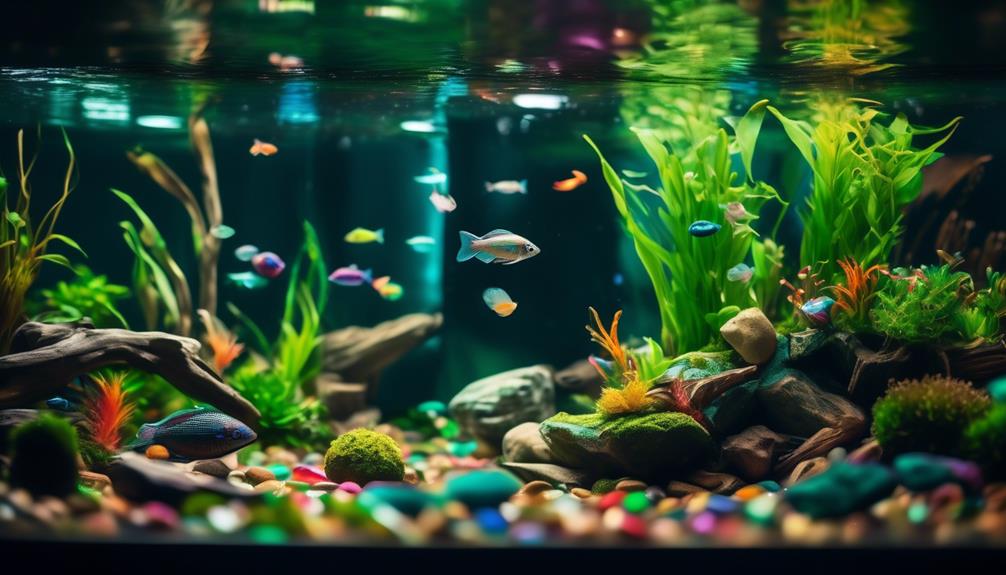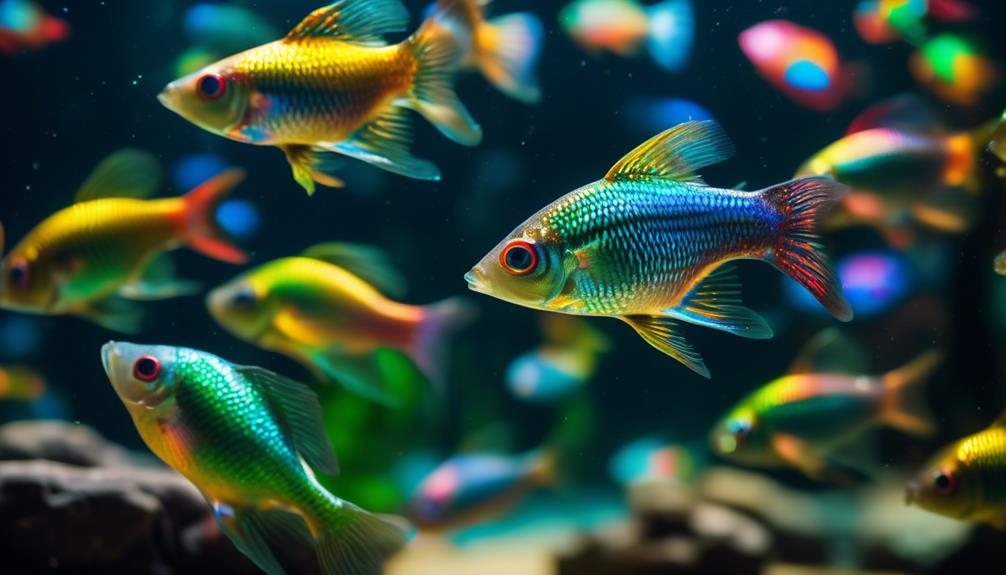Welcome to the fascinating world of colorful rainbowfish, where vibrant beauty meets tranquility in your freshwater aquarium. These exquisite creatures are renowned for their stunning array of colors, peaceful demeanor, and lively nature, making them a highly sought-after addition for both experienced aquarists and newcomers alike.
In this article, we will uncover the top ten captivating rainbowfish species, each possessing its own distinct allure. From the enchanting Boeseman's Rainbowfish to the graceful Threadfin Rainbowfish, prepare to be captivated by their elegance.
But it's not just their appearance that makes rainbowfish so intriguing; we'll also explore essential care tips, suitable tank conditions, and the benefits of keeping them in groups.
Stay tuned as we dive into the vibrant world of rainbowfish and discover why they are an absolute must-have for any freshwater aquarium.
Key Takeaways
- There are a variety of colorful rainbowfish species available for freshwater aquariums, ranging from smaller nano rainbowfish to medium-sized rainbowfish.
- Rainbowfish require a spacious tank with plenty of swimming space and a well-decorated environment with hiding spots and plants.
- Maintaining stable water temperature, pH level, and water quality is crucial for the health and well-being of rainbowfish.
- Rainbowfish are generally peaceful and can be kept in community tanks with other non-aggressive fish species that share similar water requirements.
Rainbowfish Species and Varieties
When exploring the diverse world of rainbowfish species and varieties, aquarium enthusiasts will discover a stunning array of vibrant colors and unique characteristics. Rainbowfish coloration is a captivating aspect of these fish, with factors such as genetics, diet, and environmental conditions all playing a role in their vibrant hues. Understanding these factors can help aquarists create optimal conditions for their rainbowfish to display their most vibrant colors.
Rainbowfish behavior is another fascinating aspect to explore. These fish exhibit schooling behavior and have a social hierarchy within their schools. They are generally peaceful and compatible with other peaceful fish species, but males can become territorial during courtship. Creating a well-decorated tank with hiding spots and plants can provide a sense of security for rainbowfish and allow them to exhibit their natural behaviors.
Essential Care Tips for Rainbowfish
To ensure the health and well-being of your rainbowfish, it is essential to provide them with proper care and attention. Here are some essential care tips for rainbowfish:
- Rainbowfish Diet: Rainbowfish are omnivorous and require a varied diet to thrive. Offer them high-quality flakes and pellets as their staple food. Supplement their diet with live or frozen foods such as brine shrimp, bloodworms, and daphnia to provide essential nutrients and enhance their coloration.
- Maintaining Water Quality: Rainbowfish are sensitive to water conditions, so it is crucial to maintain a clean and well-filtered aquarium. Regularly test the water parameters, including temperature, pH, ammonia, nitrite, and nitrate levels. Perform regular water changes to keep the water clean and remove any accumulated toxins.
- Keep Rainbowfish in Groups: Rainbowfish are social creatures and thrive when kept in groups of 6 or more. This helps reduce stress and encourages natural behavior. Providing a spacious tank with plenty of swimming space and hiding spots will create a comfortable environment for your rainbowfish.
Creating the Ideal Rainbowfish Habitat

Rainbowfish thrive in aquariums that closely resemble their natural habitat, providing them with the ideal conditions for their health and well-being. When setting up a tank for rainbowfish, it is important to consider their specific habitat requirements.
Rainbowfish are native to freshwater habitats in Australia, New Guinea, and nearby islands, where they inhabit various environments such as rivers, streams, lakes, and swamps. To replicate their natural habitat, it is recommended to provide a spacious tank with plenty of swimming space and dense vegetation. Rainbowfish also appreciate open spaces for swimming and exploring.
Maintaining stable water parameters, including temperature and pH levels within their preferred range, is crucial for their overall health. Additionally, offering a varied diet consisting of high-quality flakes, pellets, and live or frozen foods is essential to promote optimal health and coloration in rainbowfish.
Compatible Tankmates for Rainbowfish
In order to create a harmonious and balanced freshwater aquarium ecosystem, it is crucial to carefully select compatible tankmates for rainbowfish. Rainbowfish are known for their peaceful nature and active swimming behavior, making them suitable for community tanks. When choosing tankmates for rainbowfish, it is important to consider their behavior and social dynamics with other fish species.
Here are three suitable tankmates for rainbowfish in community aquariums:
- Tetras: Tetras are peaceful and colorful fish that share similar water requirements with rainbowfish. They come in a variety of species, such as neon tetras and cardinal tetras, and add vibrant colors to the aquarium.
- Rasboras: Rasboras are another peaceful fish species that make good tankmates for rainbowfish. They are known for their schooling behavior and come in different species, including harlequin rasboras and galaxy rasboras.
- Gouramis: Gouramis are peaceful and beautiful fish that can coexist with rainbowfish. They come in various species, such as dwarf gouramis and pearl gouramis, and add visual interest to the aquarium.
Breeding Rainbowfish in Your Aquarium

Breeding rainbowfish in the aquarium setting requires careful consideration of their reproductive behavior and specific breeding requirements. Rainbowfish are egg scatterers, meaning they release eggs that are fertilized externally. To successfully breed rainbowfish, it is recommended to provide a separate breeding tank with fine-leaved plants or spawning mops for egg deposition. After spawning, it is important to remove adult fish to prevent them from consuming the eggs. The eggs typically hatch within a week, and the fry can be fed with infusoria or commercially available fry food. Rainbowfish reach sexual maturity at around 6-9 months of age.
Breeding Rainbowfish Techniques:
| Technique | Description |
|---|---|
| Spawning mops | Provide fine-leaved plants or artificial spawning mops for egg deposition. |
| Egg collection | Remove adult fish after spawning to prevent them from consuming the eggs. |
| Fry feeding | Feed the fry with infusoria or commercially available fry food. |
| Sexual maturity | Rainbowfish reach sexual maturity at around 6-9 months of age. |
Breeding Rainbowfish Challenges:
- Maintaining optimal water conditions for successful breeding.
- Preventing adult fish from consuming the eggs.
- Ensuring proper nutrition for the fry.
- Monitoring the fry growth and development.
- Managing the increased population in the aquarium.
Frequently Asked Questions
Are Rainbowfish Suitable for Beginners or Experienced Fish Keepers?
Rainbowfish are suitable for both beginners and experienced fish keepers. Proper rainbowfish care tips include providing a spacious tank, maintaining stable water parameters, offering a varied diet, ensuring good water quality, and keeping them in groups. Common diseases of rainbowfish include ich, fin rot, and velvet.
How Long Do Rainbowfish Typically Live in Captivity?
Rainbowfish typically live for 5 to 8 years in captivity, but with proper care, they can live up to 10 years. To ensure their longevity, provide a spacious tank, maintain stable water conditions, offer a varied diet, and keep them in groups for a social environment.
Can Rainbowfish Be Kept in a Planted Aquarium?
Rainbowfish can be kept in a planted aquarium, providing a natural and visually appealing environment. The pros include enhanced aesthetics and natural behavior, while cons may include potential plant damage and increased maintenance. Maintaining water conditions involves balancing lighting, fertilization, and CO2 levels.
What Is the Ideal Tank Size for Rainbowfish?
The ideal tank size for rainbowfish is at least 20 gallons, providing ample swimming space. They are generally compatible with non-aggressive fish species such as tetras, rasboras, gouramis, and peaceful catfish.
Do Rainbowfish Require a Specific Type of Filtration System?
Rainbowfish benefit from a specific type of filtration system that provides efficient mechanical, chemical, and biological filtration. Options include canister filters, sponge filters, and power filters with adjustable flow rates to maintain optimal water quality for these vibrant and active fish.
Conclusion
In conclusion, the vibrant and peaceful nature of rainbowfish make them an excellent addition to any freshwater aquarium.
From the stunning colors of species like the Boeseman's Rainbowfish to the delicate elegance of the Threadfin Rainbowfish, each variety brings its own charm to the aquatic setting.
By providing suitable tank conditions, a proper diet, and compatible tank mates, aquarists can successfully keep and breed rainbowfish.
So, enhance the beauty of your aquarium and explore the captivating world of rainbowfish today.

